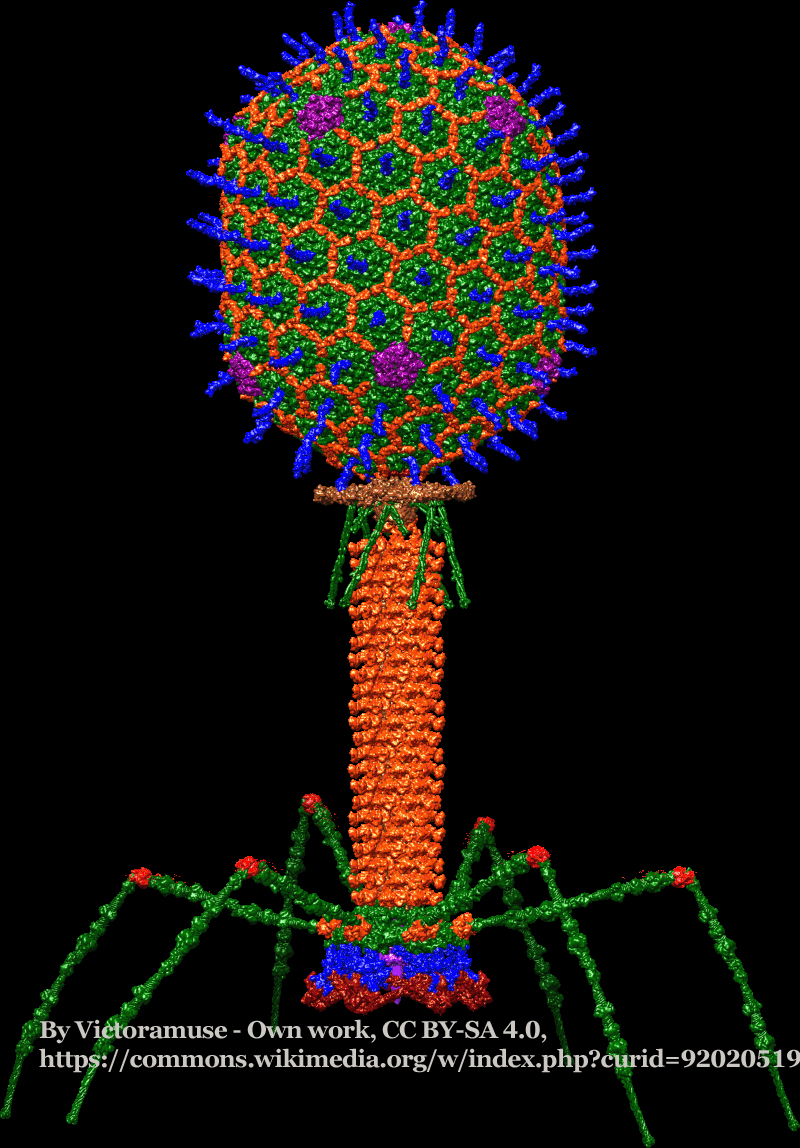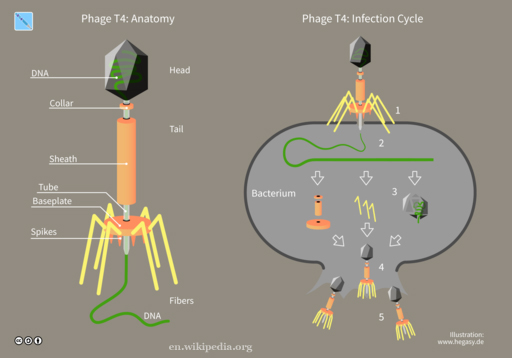BACTERIOPHAGES
Bacteriophages are good viruses! Yes, there are good viruses and there are bad viruses and then there are very bad viruses such as the one causing COVID-19. Most of us would not like to entertain the thought that some viruses are actually good and useful. After all, the word ‘virus’ comes from the Latin, literally meaning ‘slimy liquid’ or ‘poison.’
WHAT EXACTLY IS A VIRUS and HOW DOES IT CAUSE ILLNESS?
Viruses, for the most part, are nasty little organisms. In biological terms, they are relatively simple, consisting of nothing more than bits of genetic material wrapped in a protein coat. Since they can reproduce, which is the hallmark of life, one would think they would be classified as living creatures. However, there is debate about this because they cannot reproduce on their own.
Since viruses cannot reproduce on their own, they must insert their genetic material into a cell’s reproductive machinery, forcing it to crank out more viruses. As the viral load builds up, the host cells are altered or killed, causing illness.
The type of illness that ensues depends on the sort of virus. Some can be just annoying with conditions such as warts, the common cold, or chicken pox. But others can devastate health by triggering smallpox, rabies, cervical cancer, AIDS, and of course, COVID-19.
BACTERIOPHAGES
THE GOOD VIRUSES
Bacteriophages are viruses that only attack bacteria. These are the good viruses. The word, bacteriophage was coined by the person credited for their discovery, Felix D’Herelle, from the Greek ‘phagein,’ meaning ‘to eat.’
Bacteriophages can only multiply and grow inside a bacterium. Once all the bacteria are dead, they will stop multiplying. And like other viruses, phages can lay dormant (in hibernation) until more bacteria show up.
Human cells do not have receptors for these viruses, so we cannot be infected. We are actually exposed to bacteriophages all the time. They are found wherever bacteria are found, in the soil, in our water, in our food. They are the natural enemies of bacteria and help keep bacteria growth in check in nature.
FELIX d’HERELLE’s DISCOVERY
Somehow, with no formal education, the remarkable French-Canadian Felix d’Herelle, managed to set up a laboratory in his home and to train himself as a microbiologist. He pursued several interests, including the development of yeast strains to make cheap whisky from rotting fruit. His major discovery came when he was working as a volunteer at the Pasteur Institute in Paris where he was asked to investigate an epidemic of dysentery that was raging in a cavalry squadron.
d’Herelle didn’t know exactly how dysentery was spread, but suspected that it was through fecal matter. He took samples from the soldiers, placed these in a filter with microscopic pores, and passed water through. The idea was to see if the filtered deposits contained any sort of infectious agent.
Much to d’Herelle’s surprise, not only was the liquid free of any such substance, but when mixed into a bacterial culture, it caused the formation of clear spots, indicative of bacterial destruction. d’Herelle understood that what caused the clear spots was in fact an invisible microbe which was a virus parasitic on bacteria.
BACTERIOPHAGE THERAPY BEGINNINGS
d’Herelle suggested that the microscopic particles he called bacteriophages could be used to treat bacterial infections in humans and animals. George Eliava, a colleague of d’Herelle’s at the Pasteur Institute, invited d’herelle to return to his native Georgia (Russia) and set up a ‘bacteriophage’ institute. The resulting Eliava Institute has become a world leader in phage therapy, producing a great deal of research which, unfortunately, has basically been ignored in the West.
Bacteriophage therapy, therefore, is not new and has been used for years. However, the treatment isn’t well known in the US and more research is needed. This type of therapy to destroy disease-causing bacteria may be useful as an alternative to antibiotics to fight antibiotic resistance or in conjunction with antibiotics to fight certain diseases.
Although there are some concerns that viral proteins may cause allergies or that the viruses may affect some of the beneficial bacteria in our gut, there is not yet clear evidence of this.
ANTIBIOTICS VS. BACTERIOPHAGE THERAPY
Antibiotics are chemicals or drugs that destroy bacteria. They save lives and prevent disease from spreading. However, they have 2 main shortcomings:
- They can kill the bad as well as the good bacteria, which help stop bacterial, viral, and fungal infections from growing in the body.
- Antibiotics can lead to 'superbugs.' Resistance happens when bacteria evolve or change to become stronger than the antibiotics.
A bacteriophage can be used to directly
target certain disease-causing bacteria because each kind of phage will only
attack a certain bacterium, not any other kinds of bacteria. For example, a
strep bacteriophage will only kill bacteria that cause strep throat infections.
Thus, bacteriophage therapy appears to address the shortcomings of antiobiotics.
Infection cycle of bacteriophage.
1: Attachment of phage's fibres to a bacterium.
2: Injection of DNA.
3: Synthesis of phage components.
4: Assembly of new phages.
5: Burst of bacterium and release of infectious phages.
BACTERIOPHAGES and LISTERIA
Eyebrows were raised when the Food and Drug Administration approved a ‘virus cocktail’ to be used to specifically destroy Listeria monocytogenes by being sprayed on certain meat products. How could the FDA approve the adding of viruses to our food supply?
Listeria bacteria (named after Joseph Lister, the British surgeon who first recognized the need to keep microbes out of the operating room) can turn up in our food supply and cause a great deal of human misery to animals and humans. Once they infect the body, they can wreak havoc all the way from flu-like symptoms, fever, headache, vomiting, cramps, and diarrhea to blood poisoning (septicemia) if they can get into the bloodstream, or, if they invade the brain or spinal cord, meningitis.
These conditions can be lethal if not appropriately treated with antibiotics. The young, the elderly, the immune-compromised, and pregnant women are most susceptible to infection. Listeriosis in early pregnancy can cause a miscarriage and in later pregnancy, a still birth. To make matters worse, a victim may not easily connect the symptoms of listeriosis to food because these can present anywhere from a couple of days to 3 months after consuming a contaminated product.
Unpasteurized milk, soft-ripened cheeses, raw and smoked fish, uncooked hot dogs, cold cuts, vegetables can all harbor Listeria. Washing vegetables well, cooking meat products thoroughly, and avoiding unpasteurized milk can go a long way to controlling Listeria, but cannot eliminate all risk. After all, we don’t wash or sliced turkey or chicken after opening the package. To make matters worse, Listeria constitute one of the few bacterial species that can multiply at refrigerator temperatures. More than 500 people a year in North America die from listeriosis and bacteriophage treatment of some of our foods can help reduce this.
OTHER USES FOR BACTERIOPHAGES
The FDA has approved of some other phage mixtures to help stop bacteria from growing in foods. These include salmonella, E.coli, Mycobacterium tuberculosis, Campylobacger, and Pseudomonas.
Another use for bacteriophages that is being tested involves adding them to cleaning products to destroy bacteria on surfaces. This may be beneficial in places such as hospitals and restaurants.
MORE RESEARCH NEEDED
The main disadvantage of Bacteriophage therapy at this time (as of January 2021) is that it is not yet widely used and has not been approved for people in the United States or in Europe.
There has been experimental phage used in
a few rare cases only. In June of 2018, the Center for Innovative Phage Applications and Therapeutics (IPATH) was created at the University of California, San Diego after the first successful case of intravenous bacteriophage therapy to treat a systemic multidrug-resistant infection took place at the University.
More research is needed to find out how well it works and whether or not it may harm people or animals in ways unrelated to direct toxicity. At this time, antibiotics are more easily available and considered to be safer to use.
Yes, there are good viruses and they are called bacteriophages! Hopefully, continuing research in the near future may give us yet another way to fight disease and could be as important a weapon as antibiotics are now.
Please note: a portion of this article came from information used with permission from the McGill University Office for Science and Society.
"The Cleanest Clean You've Ever Seen."
by
ABC Oriental Rug & Carpet Cleaning Co.
130 Cecil Malone Drive Ithaca, NY 14850
607-272-1566
ABC Oriental Rug is on Facebook!
We regularly post tips and information about your carpet, rugs, upholstery, and tile and grout so please visit us often.
We update our Facebook page with our latest discounts and we are also offering exclusive promotions to our Facebook fans. These are limited and short notice promotions.
When you like our page, you will also be able to claim your special gift from us!
"Like Us"
on Facebook
and find out
what's going on!
We would love to send our monthly newsletter directly to YOUR INBOX.
Just sign up below...
(Your email is safe with us. Your privacy is our priority.)
Viewing Us on Mobile?
Text to Join Below...

ABC
Carpet & Rug
Spotting Guide
Learn how to remove spots with ordinary household solutions
Sign up below to gain access to your complementary Spotting Guide from ABC.
Registering your email address guarantees you will be notified whenever discount savings coupons become available.




